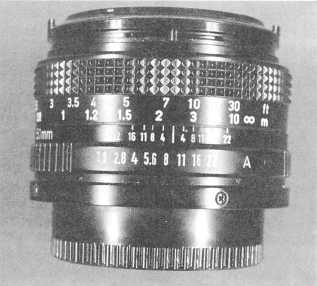Figure 4-7.–Focusing scale.
302.268
increased. Both near and far points will appear in focus.
In photographing the scene for a visitor, you may want
to emphasize only the entrance way to the building,
rather than concentrating on getting everything in the
picture in sharp focus.
Focusing Systems
Accurate focusing and framing are essential to good
pictures, and modern cameras have many devices to
help you get good focusing and framing results.
Because of the principles of depth of field, simple
cameras are manufactured without any way of adjusting
focus. The lenses of these simple cameras are
prefocused at the hyperfocal distance. Remember from
chapter 1, that the hyperfocal distance for a lens is
determined by the focal length and the aperture. That
allows “point and shoot,” ID, and passport cameras to
produce pictures where everything from about one half
of the hyperfocal distance through infinity are
acceptably sharp.
Focusing is accomplished by adjusting the distance
from the lens to the film. It does not matter which of the
two is actually moved, the lens or the film. With
hand-held cameras the lens is moved in and out. Usually
on large-copy cameras, the camera back (film plane) is
moved toward or away from the lens, That is because
the distance from the photographer to the lens board is
usually too great to focus through the ground glass.
No matter what system you use to focus the camera,
there must be a means for you to determine when the
image is in focus. Some cameras have autofocusing
systems. Most camera systems used by Navy personnel
are focused manually.
Focusing Scale
This is the simplest type of focusing system. It uses
a scale of distances that indicates the distance where the
focus is set. Primarily, these scales are engraved on the
lens barrel. To use the focusing scale, you can measure
the camera-to-subject distance, but, in most cases, you
must estimate the camera-to-subject distance. This
distance is then set to the focus index mark on the lens
(fig. 4-7). Scale focusing can be useful when you
anticipate quick action but do not have sufficient time
to focus the camera. When using scale focusing, a small
f/stop is helpful so you can rely on depth of field to
provide an acceptably sharp image.
Ground Glass Focusing
With some cameras, focusing is done by viewing
the image on a glass screen, called a ground glass. The
image formed by a view camera is projected directly to
the ground glass for viewing and focusing. Accurate
focusing can be achieved using a ground glass. There is
a drawback to this type of focusing. Because of the
texture of the ground glass, very fine detail of the image
is difficult to distinguish. That results in some leeway in
focusing. Additionally, when you work too long at
focusing the image, your eye will adjust and accept an
image that is less than sharp. For this reason, it is helpful
to place a magnifying loop directly on the ground glass.
That helps in focusing quickly and accurately.
A ground glass focusing system shows directly the
image that will appear on the film. The image size and
depth of field records on the film the same as it appears
on the ground glass. Ground glass focusing systems are
commonly found on copy cameras and view cameras.
The image on the ground glass appears upside down and
backwards.
Reflex Focusing
A reflex focusing system also uses a ground glass
or focusing screen; however, instead of the image being
4-6


